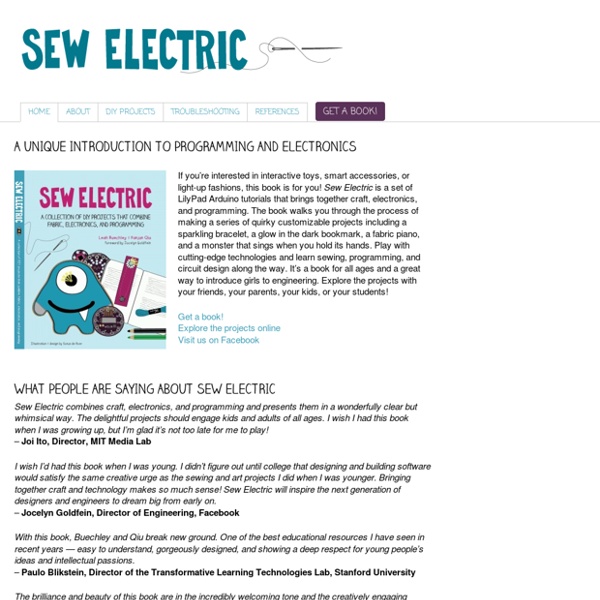



The 10 Most Amazing Electronic Clothes Of the Century Computers? Clothes? What's the difference? Let’s face it, without the technology you use everyday you’d be pretty stuck. Need to make a big impression at a formal event? Why buy computerized clothing when you can make your own? Kanjun Qie from MIT Media Lab made a really cool sound-producing hoodie called the Soundie. Not useful enough? For those of us with a little electronics know-how the Arduino Lilypad is definitely a great option to make some kick-ass electronic-wear. Sports injuries can take years to overcome, and when you’re a professional athlete they can cost you a lot more than time. Also by Cute Circuit, the Hug Shirt stands on a basic premise: we all want to reach out and touch someone. The Hug Shirt lets you hug yourself and send a warm feeling to someone on the other side of the planet. ...This is a situation ripe for abuse. So maybe you want to put some electronics in your clothes, but you don’t want to do all the design yourself.
Arduino LilyPad for Clothing Overview The LilyPad Arduino is a microcontroller board designed for wearables and e-textiles. It can be sewn to fabric and similarly mounted power supplies, sensors and actuators with conductive thread. The board is based on the ATmega168V (the low-power version of the ATmega168) (datasheet) or the ATmega328V (datasheet). The LilyPad Arduino was designed and developed by Leah Buechley and SparkFun Electronics. Downloads Schematic: LilyPad_schematic_v18.pdf EAGLE (CAD) Files: LilyPad_Board_v18.zip Summary Warning: Don't power the LilyPad Arduino with more than 5.5 volts, or plug the power in backwards: you'll kill it. Programming The LilyPad Arduino can be programmed with the Arduino software (download). The ATmega168V or ATmega328V on the Arduino LilyPad comes preburned with a bootloader that allows you to upload new code to it with the Arduino software. Power The LilyPad Arduino can be powered via the USB connection or with an external power supply. Physical Characteristics Washability
Clothing Gets Computerized Sure those name brand threads may look good, but when was the last time they allowed you to become a walking sound and light show? The Soundie, part hoodie and part electric keyboard, is a build-it-yourself project now featured on the Instructables website. By touching the Soundie at different points and with different numbers of fingers, different pitches and lights will activate. Vary the amount of contact and you change the light and sound. It turns your hoodie into a musical instrument you can wear. Can your hoodie play songs? The Soundie works by measuring voltage differences across special iron-on conductive fabric. Along with augmented reality video merging, and total-body interaction media, the Soundie is part of a larger trend of immersion technologies. But we’re totally skipping the other amazing part of the Soundie: it’s build it yourself! The Arduino LilyPad microcontroller board - sew cool!
OMSignal un t-shirt connecté mesure la respiration et le pouls OMSignal fabrique des t-shirts connectés composés de textiles intelligents permettant de mesurer la respiration et le pouls et de transmettre ces informations à un smartphone via bluetooth. Au croisement du prêt-à-porter, du Quantified Self et de l’innovation technologique se trouve OMSignal. La société montréalaise design et fabrique ses propres vêtements intelligents, composés de fibres textiles d’un nouveau genre. Les fibres mise-au-point par OMSignal intègrent de nombreux capteurs permettant de mesurer plusieurs paramètres: pouls, respiration, humidité et température de la peau, humidité et température extérieures, nombre de pas effectués et activité physique. A partir de ces données, le tissu détermine ainsi les calories brûlées par le porteur, ainsi que son état émotionnel – stressé, détendu, etc. Voyez cette vidéo pour mieux comprendre Hexoskin : L’ambition d’OMSignal ? Stephane Borreman, CMO d’OMSignal et médecin de formation, explique : Le secret d’OMSignal :
OMsignal’s smart shirt monitors your emotional well-being A host of fitness tracking tech is currently on the market allowing users to measure and monitor their daily activities, heart rate, exercise intensity and even how much they sweat. But what about your emotional state? Montreal-based smart apparel company OMsignal has developed a T-shirt and a bra that not only tracks your daily steps, calorie burn and heart rate, but it also measures your breathing and emotional well-being using your heart rate variability, or HRV, reported VentureBeat. OMsignal's clothing contains a 3-axis accelerometer, the basic tool found in other fitness devices, which measures motion, steps and calories. It also detects and measures two other signals: your ECG—the electrical signature of your heart—and respiration rhythms. Sensors woven into the polyester/lycra fabric act as a 3-lead EKG, producing a readout of cardiac activity when the user is at rest or doing something active, according to the company. Photo: OMsignal/Marlon-Kuhnreich